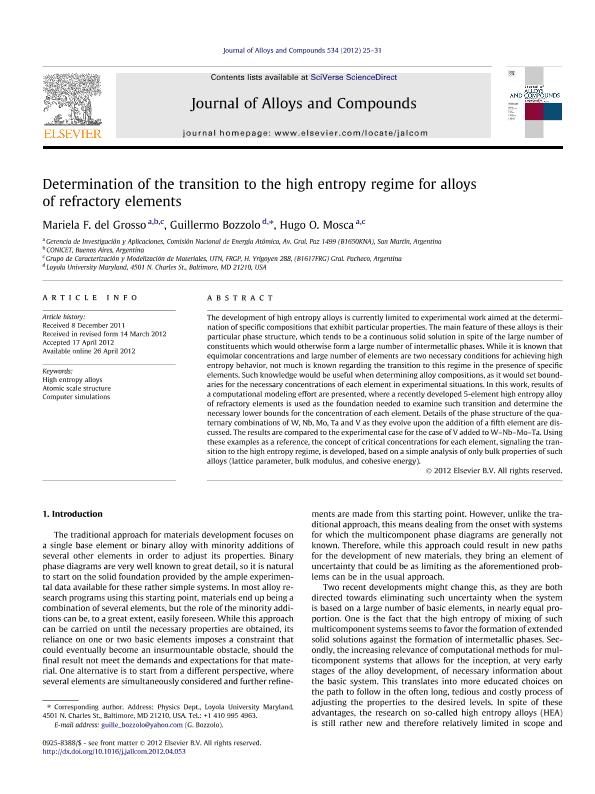Mostrar el registro sencillo del ítem
dc.contributor.author
del Grosso, Mariela Fernanda

dc.contributor.author
Bozzolo, Guillermo
dc.contributor.author
Mosca, Hugo Osvaldo

dc.date.available
2023-03-10T10:22:29Z
dc.date.issued
2012-04
dc.identifier.citation
del Grosso, Mariela Fernanda; Bozzolo, Guillermo; Mosca, Hugo Osvaldo; Determination of the transition to the high entropy regime for alloys of refractory elements; Elsevier Science SA; Journal of Alloys and Compounds; 534; 4-2012; 25-31
dc.identifier.issn
0925-8388
dc.identifier.uri
http://hdl.handle.net/11336/190134
dc.description.abstract
The development of high entropy alloys is currently limited to experimental work aimed at the determination of specific compositions that exhibit particular properties. The main feature of these alloys is their particular phase structure, which tends to be a continuous solid solution in spite of the large number of constituents which would otherwise form a large number of intermetallic phases. While it is known that equimolar concentrations and large number of elements are two necessary conditions for achieving high entropy behavior, not much is known regarding the transition to this regime in the presence of specific elements. Such knowledge would be useful when determining alloy compositions, as it would set boundaries for the necessary concentrations of each element in experimental situations. In this work, results of a computational modeling effort are presented, where a recently developed 5-element high entropy alloy of refractory elements is used as the foundation needed to examine such transition and determine the necessary lower bounds for the concentration of each element. Details of the phase structure of the quaternary combinations of W, Nb, Mo, Ta and V as they evolve upon the addition of a fifth element are discussed. The results are compared to the experimental case for the case of V added to W-Nb-Mo-Ta. Using these examples as a reference, the concept of critical concentrations for each element, signaling the transition to the high entropy regime, is developed, based on a simple analysis of only bulk properties of such alloys (lattice parameter, bulk modulus, and cohesive energy).
dc.format
application/pdf
dc.language.iso
eng
dc.publisher
Elsevier Science SA

dc.rights
info:eu-repo/semantics/openAccess
dc.rights.uri
https://creativecommons.org/licenses/by-nc-sa/2.5/ar/
dc.subject
ATOMIC SCALE STRUCTURE
dc.subject
COMPUTER SIMULATIONS
dc.subject
HIGH ENTROPY ALLOYS
dc.subject.classification
Física de los Materiales Condensados

dc.subject.classification
Ciencias Físicas

dc.subject.classification
CIENCIAS NATURALES Y EXACTAS

dc.title
Determination of the transition to the high entropy regime for alloys of refractory elements
dc.type
info:eu-repo/semantics/article
dc.type
info:ar-repo/semantics/artículo
dc.type
info:eu-repo/semantics/publishedVersion
dc.date.updated
2023-03-09T14:38:21Z
dc.journal.volume
534
dc.journal.pagination
25-31
dc.journal.pais
Países Bajos

dc.journal.ciudad
Amsterdam
dc.description.fil
Fil: del Grosso, Mariela Fernanda. Comisión Nacional de Energía Atómica; Argentina. Consejo Nacional de Investigaciones Científicas y Técnicas; Argentina
dc.description.fil
Fil: Bozzolo, Guillermo. Loyola University Maryland; Estados Unidos
dc.description.fil
Fil: Mosca, Hugo Osvaldo. Comisión Nacional de Energía Atómica; Argentina
dc.journal.title
Journal of Alloys and Compounds

dc.relation.alternativeid
info:eu-repo/semantics/altIdentifier/url/https://www.sciencedirect.com/science/article/abs/pii/S0925838812007177
dc.relation.alternativeid
info:eu-repo/semantics/altIdentifier/doi/http://dx.doi.org/10.1016/j.jallcom.2012.04.053
Archivos asociados
